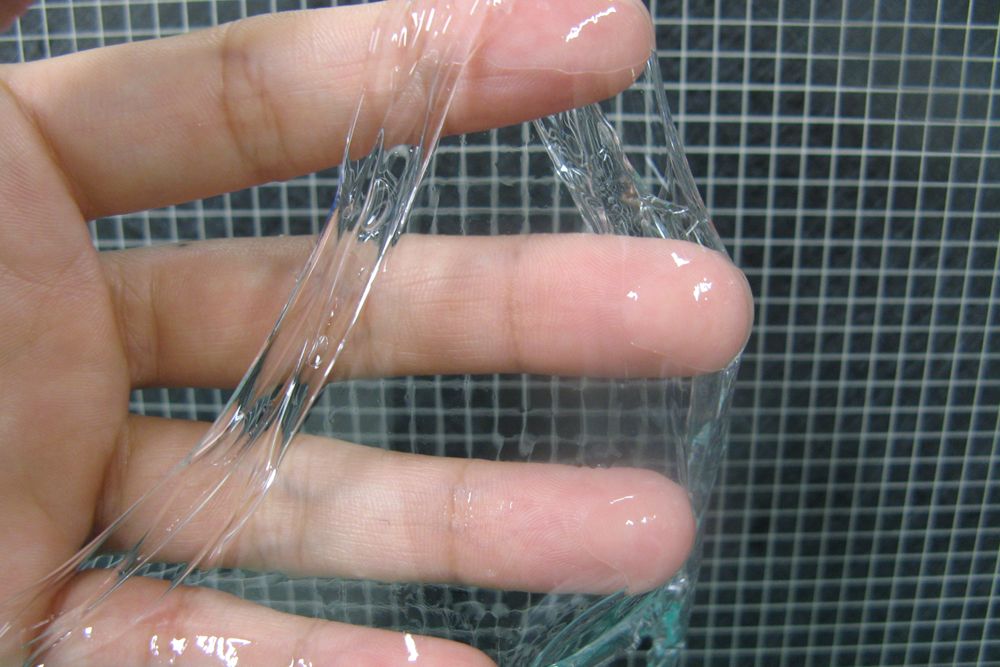How Hydrogels and Japan Changed a Life

Have you eaten a piece of Jell-O lately? It is a hydrogel. Have you ever worn a contact lens? Hydrogel. Changed a baby diaper and wondered how it held the liquid in? Yep, you guessed it! The lining in baby diapers also contains dried hydrogels.
Hydrogels are three-dimensional materials that are hydrophilic, or water loving. Fully swollen hydrogels typically contain more than 90 percent water. Since they are primarily water, their mechanical properties — such as brittleness or elasticity — are relatively poor, thus they tend to be soft and fracture easily.
For the last three years, I have studied hydrogels in the lab of Stevin Gehrke at the University of Kansas. Materials found in nature are superior to man-made ones; therefore, we use nature as a model. Specifically, we use proteins and polysaccharides found in the extracellular matrix. The ECM is a highly ordered and complex material found in tissues and organs, and has excellent toughness. Mimicking these tissues with synthetic hydrogels would advance tissue engineering for repair of damaged or diseased tissues. I have created strong biocompatible hydrogels that have the ability to encapsulate cells. These properties are important for the use of tissue engineering scaffolds.
In the summer of 2011, as a participant in NSF's East Asia and Pacific Summer Institutes Program (EAPSI), I spent 90 days in Japan, most of the time at Hokkaido University in Sapporo, Hokkaido. Sapporo, the fifth largest city in Japan, is densely populated with about 2 million people. But Hokkaido, second largest and northernmost island, is not very populated compared to the rest of Japan. Japan has beautiful sights, wonderfully deep cultural roots, delicious food and extremely hospitable people.
But this is not why I went to Japan. I went because pioneering work and one of the world's most renowned scientists in the area of hydrogels is at Hokkaido University. Professor Jian Ping Gong is known for her work on double-network hydrogels. These DN hydrogels were the first to be identified with mechanical properties resembling biological structures such as cartilage. Professor Gong and her laboratory group helped guide my project, which examined DN hydrogels of biological components.
At Hokkaido University I learned how to make DN hydrogels with minimal oxygen, since oxygen hinders hydrogels from forming. I learned how to use a gel cutting device, which reduces cracks that lead to premature failure. Also, the Japanese researchers taught me the techniques for measuring the mechanical properties of hydrogels, such as tear tests to calculate toughness and tensile tests to study fracture properties. I have adapted these techniques to my projects at Kansas University.
At Hokkaido University, the students had a work-hard-and-play-hard mentality. Many students worked 12-hour days, Monday to Saturday, plus several hours on Sundays. They also participated in sports, games and trips. Professor Gong's lab group treated me like family. We went on a trip together and played in a volleyball tournament (my team won!). On this trip I taught them the pop dance called the "cupid shuffle" and we even went to an onsen, a Japanese hot springs bath. On my birthday, the lab group bought me a birthday cake, and together we made gyoza (dumplings). The lab also dressed me in traditional attire. One of my favorite experiences with the lab group was the Mongolian style BBQ. We set up grills, added food to them and just ate off of the grills. There was so much food: beef, chicken, veggies, rice, seafood — yum! We made flowing "somen" — noodles that flowed down long bamboo flumes, which we caught with chopsticks at the bottom. Around Sapporo we went to festivals, beer gardens, baby showers, church, temples and had get-togethers. I made lifelong friends.
Sign up for the Live Science daily newsletter now
Get the world’s most fascinating discoveries delivered straight to your inbox.
I traveled to many places in Hokkaido with other EAPSI students. We went to parks where we saw foxes, bears and other wildlife up close. We explored the city. We ate at so many delicious places, but my favorite was a little soup curry shop. Among the many different base flavors one could order, my favorite was coconut. It came with lots of fresh vegetables and your choice of meat.
On my own, I traveled by bullet and local trains exploring Nikko, Utsnomiya, Tokyo, Kyoto, Nara, Osaka, Saijo, Hiroshima, Nagasaki, Iojima Island, Unzen, Shimabara and Kumamoto. During my travels I tried unique food such as raw horse meat, sushi, ramen, curry and okonomiyaki (savory Japanese pancakes). I even located some distant family by going door-to-door in Hiroshima.
This research and cultural experience will pull me back to Japan in the very near future.
Editor's Note: This research was supported by the National Science Foundation, the federal agency charged with funding basic research and education across all fields of science and engineering. Any opinions, findings, and conclusions or recommendations expressed in this material are those of the author and do not necessarily reflect the views of the National Science Foundation. See the Behind the Scenes Archive.












